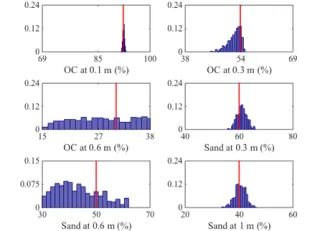While characterization of soil organic content (SOC) and its influence on hydro-thermal dynamics are critical for predicting ecosystem feedbacks to climate, such characterization is typically challenging due to the general limitations of conventional core-based methods and the extremely dynamic nature of hydrological-thermal processes associated with freeze-thaw behavior. In this study, we develop and test an inversion scheme that can flexibly use single or multiple datasets, including soil liquid water content, temperature and electrical resistivity tomography (ERT) data, to estimate the vertical distribution of SOC content. Our approach relies on the fact that SOC content strongly influences soil hydrological-thermal parameters, and therefore, indirectly controls the spatiotemporal dynamics of soil liquid water content, temperature and their correlated electrical resistivity. We employ the Community Land Model (CLM) to simulate nonisothermal surface-subsurface hydrological dynamics from the bedrock to the top of canopy, with consideration of land surface processes (e.g., solar radiation balance, evapotranspiration, snow accumulation and melting) and ice/liquid water phase transitions. We develop an inversion approach that combines deterministic and an adaptive Markov chain Monte Carlo (MCMC) optimization algorithm to estimate posterior distributions of desired model parameters, such as SOC. We developed petrophysical models to link the hydrological-thermal-geophysical parameters. We tested and validated the new inversion scheme using different numerical experiments, and evaluated sensitivities and errors. We find that the joint inversion of geophysical and other datasets significantly reduced the uncertainty of estimating SOC, and that the approach was able to estimate SOC and sand content within the shallow active layer (top 0.3 m of soil) with high reliability. However, due to the small variations of temperature and moisture within the shallow permafrost (here at about 0.6 m depth), the approach was unable to estimate permafrost-bound SOC with confidence. Ongoing work is focused on using autonomously collected, field scale ERT data to estimate SOC and associated hydro-thermal dynamics at the NGEE site.
For more information, please contact:
Anh Phuong Tran


